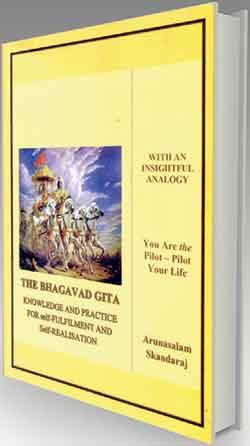07 Jan 2020 - {{hitsCtrl.values.hits}}
 Among the Hindu scriptures perhaps the Bhagavad Gita is the best known to the outside world.
Among the Hindu scriptures perhaps the Bhagavad Gita is the best known to the outside world.
Somehow the world is made to think that the Bhagavad Gita is the Bible equivalent of Hinduism. That is not totally incorrect, either.
Unlike other religions, Hiduism does not follow one book. The Bhagavad Gita is –to put it in simple terms- the essence of the Vedas, the four basic scriptures in Hinduism. There are several versions of the Bhagavad Gita- hundreds maybe-with Adi Shankaracharya (Advaita) and the other by Ramanuja (Vishishtadvaita) versions being sought after but they are of a higher standard and they demand a deeper understanding of Hindu Theology.
Swami Prabhupada’s Bhagavad Gita As It Is Original authorized Macmillan (1972) is perhaps the most known in the West. But there are many criticisms on it and sometimes it is called as the Abrahamic Version.
The book is written in a day-to-day language and all 18 chapters are summarised in simple English...
Many editions are not as good as the acharyas and swamis have imposed their opinions and are kind of distorted.
Another standard edition is the Jittu Krishnamorrthy’s commentary. But this too is a very demanding book. These versions are not for the newcomer or the uninitiated.
And there will be hundreds more, which we are not aware of.
Recently I was introduced to an English version of the book, written by Arunasalam Skandaraj, an ex-corporate executive and a one-time member of the Chinmaya Mission Worldwide. He had titled his version of the Gita as The Bhagavad Gita -Knowledge and Practice for Self-fulfilment and Self-realisation. “The supreme value of the Gita lies in its harmony with the individual, societal or mutual, and the universal. It makes us realize the effective and unfailing means of self-fulfilment and self-transcendence. Its appeal is universal as duty, love and wisdom are universal.
The universality of Gita depends on the certainty of universal life and faith and requires only change of life based on virtues, change of attitude embracing oneness in life, change of method in the contact with the world and change of discipline to progress on the right path,” the author says in his introduction. The book is targeted to the average reader. A non-Hindu or whoever taking his/her first step towards spirituality or Hindu Theology/Thought.
In fact, the author told this writer that the book was intended as a gateway- a portal to Hinduism- to the followers of other faiths. However, the intention was not conversion of faith.
Having said that the book is written in a day-to-day language and all 18 chapters are summarised in simple English. However, one minus is the interfering references to the verses in brackets, which make the reading a tad tedious. The reading would have been easier if not for these brackets.
Besides, the author has two more self-help books he had written previously as addenda, which is a plus.
“All religions declare the divine nature of the soul-whether their affirmation is one of identity, the union of similarity. The goal of human endeavour is the attainment or realisation of its unity or identity with God. “The knowledge of the real world the creation and the creator, and practices he means expounded in the Gita is but a sure path to self-fulfilment and self-realisation and God-realisation,” are two quotes worth considering in the book.

25 Apr 2024 51 minute ago
25 Apr 2024 1 hours ago
25 Apr 2024 2 hours ago
25 Apr 2024 2 hours ago
25 Apr 2024 3 hours ago